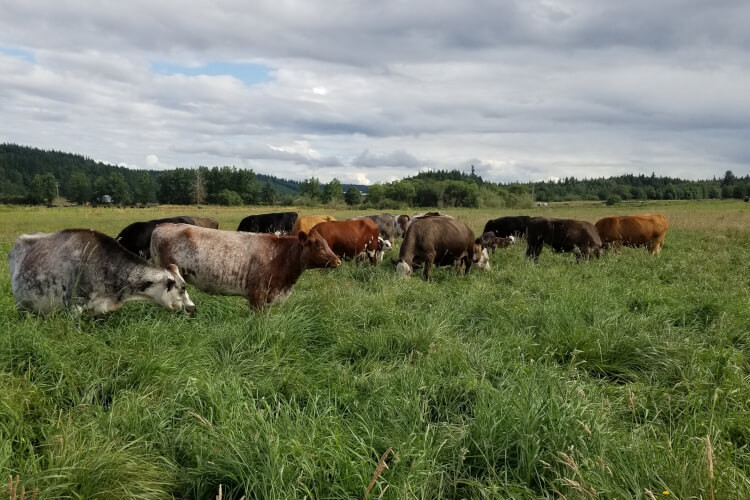Over The Rainbow
posted on
March 17, 2021

One of our most frequently asked questions is some form of “why are you farming?” It’s a great question with many difficult to articulate and interwoven answers! But on this St. Patrick’s Day it seems a fitting time to share one of my all-time favorite photos and, with it, my over-the-rainbow tale. Last year Martin gave a glimpse into his farming epiphany story (you can read it here). He introduced you to his journey through the Peace Corp in Africa, his calling to be an instrument of positive change, and how that mission ultimately led him home to grow good food for his neighbors.
My story is different. In the end it is, really, a love affair. And not the one, as you’re probably thinking, with my entrepreneurial husband! Many years before I met Martin, I was helping my parents in a small way with their beef cattle herd. One year for Christmas my parents decided to give each of my brothers and I a cow to manage in the herd. The profit (or loss) from our management decisions was our farm wages. My brothers usually sold their calves to save up money, but I kept all the heifer calves to grow my own herd. An infatuation commenced, and with each cute little calf it grew stronger.
Then one day something seemingly insignificant happened. A woman offered me the purchase of her family milk cow. I pondered the idea and remembered, as a small girl, going to hand milk a cow with my Grandma who as a girl had worked on her parents’ small dairy farm. It was a brief memory, but a special one. I went to see the cow. Her name was Alba.
I brought her home. And I fell in love. A voracious reader, I devoured books about dairy cows. I talked to my Grandma and gleaned her dairywoman’s experience. I was gifted much advice and assistance from my parents. But in the end it was Alba herself who really taught me to milk a cow. And to appreciate the cow-ness of a cow; their dignity, stubbornness, and innate naughtiness in the face of calm, reasonable requests. With many clever tricks designed to impart instant fury, she trained me in the art of swearing like a sailor! But then she would sweetly lick my face (ouch! those tongues are rough) and sidle around so I could more easily scratch her favorite places. Willingly she gave me buckets of milk to nourish my body, while all the time nourishing my soul.
Eventually I met Martin and of course Alba came to live with us. She even let him milk her once. Alba lived out a good long life with us, long past the time when she no longer could gift us with calves or milk. Still, she mowed the lawn as we moved her on a tether from place to place. She was that lucky cow who finally got to eat the grass that sometimes is actually greener on the other side of the fence! And she gave me the joy of her gentleness with our small child as he learned to admire what to him must have seemed an enormous, potentially frightening creature.
There are many reasons I am a farmer. Many people and circumstances have caused my path to curve in the direction it has followed. But when I think long and hard about it, Alba is the reason my heart is on that path.
Some might ask how this is possible – this devotion to an animal, on the surface so incompatible with the reality that our livelihood is raising animals for food. Actually, there is no antagonism here and it matters a great deal to understand this seeming conundrum. We raise animals because we love being near them, spending time with them, sharing this world with them. And through our intimate relationship with these amazing creatures, from birth to death, we see the absolute necessity of their company in the intricate web of our ecological system. Life requires death, and we are privileged to be in a place of deep communion with this truth. We are able to reconcile our devotion to our animals with our call to care for all of Creation as our destinies are bound together – the animals, the earth, and we humans who are nourished by them.
There is also a practical importance to our personal love stories with particular creatures. We do not, and cannot, forge intimate friendships with all of our livestock. So the bonds with those special ones that stay in our hearts matter all the more, because raising livestock is hard work. And animals can be stubborn, contrary, and downright problematic. So when a fence is disregarded, a gate is refused, or an injury requires unceasing care, to have a deep appreciation for the inherent dignity of the animal is invaluable in guiding our understanding, care and compassion.
Alba has been gone for several years, and while I still miss her it is with a sweet fondness for our friendship and gratitude for the bovine knowledge she gifted to me. Fortunately, the children haven’t yet heard the blue words she taught me – I know the day is coming. Just like in every love story there was good and bad together, which made it true.





